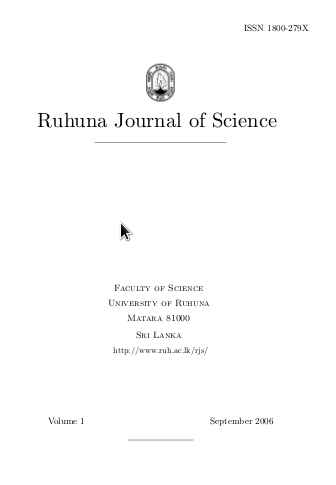Biological control of Fusarium oxysporum f.sp. radicis-cucumerinum, the casual agent of root and stem rot of Cucumis sativus by non-pathogenic Fusarium oxysporum
Abstract
The aim of this study was to evaluate the ability of non-pathogenic F. oxysporum isolates from suppressive soil in Sri Lanka to control Fusarium root and stem rot of Cucumis sativus L. (cucumber) under greenhouse conditions. Three non-pathogenic F. oxysporum isolates were included in the study. Fusarium isolates were first checked in vitro for pathogenic and antagonistic potential. In greenhouse evaluations, the non-pathogenic F. oxysporum iso- lates were introduced to root system just before the seedlings were replanted in pathogen infested soil. The plants were evaluated for disease development after three weeks. Results of the greenhouse pot experiments revealed that, two non-pathogenic F. oxysporum iso- lates significantly reduced Fusarium root and stem rot incidence. However, combining the non-pathogenic fungal isolates did not enhance the plant protection. These data provide evidence that the non-pathogenic isolates have potential to protect cucumber plants from Fusarium-rot. The most appropriate mechanism of action behind the disease suppression in this system would be suppression of saprophytic growth of the pathogen and depriving a niche rather than direct antagonism.References
Alabouvette C, Lemanceau P, Steinberg C, 1993. Recent advances in the biological control of Fusarium wilts. Pesticide Science 37, 362-73.
Blok WJ, Zwankhuizen MJ, Bollen GJ, 1997. Biological control of Fusarium oxys-porum f. sp. asparagi by applying non-pathogenic isolates of F. oxysporum. Bio-control Science and Technology 7, 527-41.
Booth C, 1977. Fusarium: Laboratory guide to the identification of the major species. Kew, UK: Commonwealth Mycological Institute.
Duijff BJ, RecorbetG, Bakker PAHM, Loper JE, Lem P, 1999.Microbial antagonism at the root level is involved in the suppression of Fusarium wilt by the combination of nonpathogenic Fusarium oxysporum Fo47 and Pseudomonas putida WCS 358. Phytopathology 89, 1073-79.
Edel V, Steinberg C, Avelange I, Laguerre G, Alabouvette C, 1995. Comparision of three molecular methods for the characterization of Fusarium oxysporum strains. Phytopathology 87, 693-697.
Jaizme-vega MC, Hernandez BS, Hernandez JMH, 1998. Interaction of arbuscular mycorrhizal fungi and the soil pathogen Fusarium oxysporum f.sp. cubense on the first stages of micropopagated Grande Naine banana. Acta Horticulture 490, 295-95.
Lemanceau P, Alabouvette C, 1993. Suppression of Fusarium wilts by fluorescent pseudomonads: mechanisms and applications. Biocontrol Science and Technology 3, 219-34.
Lemanceau P, Bakker PAHM, De Kogel WJ, Alabouvette C, Schippers B, 1992. Effect of pseudobactin 358 production by Pseudomonas putida WCS 358 on sup- pression of Fusarium wilt of carnations by nonpathogen Fusarium oxysporum Fo47. Applied and Environmental Microbiology 58, 2978-82.
Nel B, Steinberg C, Labuschagne N, Viljoen A, 2006. Isolation and characterization of non-pathogenic Fusarium oxysporum isolates from the rhizosphere of healthy banana plants. Plant Pathology 55, 207-216.
Park CS, Paulitz TC, Baker R, 1988. Biocontrol of Fusarium wilt of cucumber result- ing from interactions between Pseudomonas putida and non-pathogenic isolates of Fusarium oxysporum. Phytopathology 78, 190-4.
Downloads
Published
Issue
Section
License
From Volume 7 (2016) onwards, all articles published in Ruhuna Journal of Science are Open Access articles published under the Creative Commons CC BY-NC 4.0 International License. This License permits use, distribution and reproduction in any medium, provided the original work is properly cited and is not used for commercial purposes.
Copyright on any research article published in RJS is retained by the respective author(s).
Authors who publish with this journal agree to the following terms:
a) Authors retain copyright and grant the journal right of first publication with the work simultaneously licensed under a Creative Commons Attribution License CC-BY-NC 4.0 International, that allows others to share the work with an acknowledgement of the work's authorship and initial publication in this journal.
b) Authors are able to enter into separate, additional contractual arrangements for the non-exclusive distribution of the journal's published version of the work (e.g., post it to an institutional repository or publish it in a book), with an acknowledgement of its initial publication in this journal.
c) Authors are permitted and encouraged to post their work online (e.g., in institutional repositories or on their website) prior to and during the submission process, as it can lead to productive exchanges, as well as earlier and greater citation of published work (See The Effect of Open Access).

